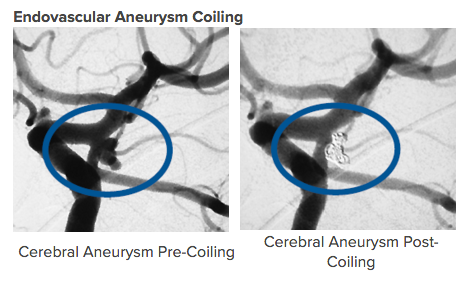Aneurysms
Brain aneurysm symptoms and treatment
A brain aneurysm is a weak, bulging spot in a blood vessel in the brain. They can grow undetected for years. In fact, some studies suggest 1 in 50 of us have an aneurysm and don’t even know it. But sometimes the arterial walls around an aneurysm can become so thin and weak that they burst, allowing blood to flow into the open spaces around the brain.
Brain Aneurysm Symptoms
A burst aneurysm is a medical emergency. Sometimes an aneurysm displays no symptoms. However, you should call 911 immediately if someone is experiencing these symptoms, as they could indicate a bleeding aneurysm:
- Severe headache (worst headache of your life)
- Dilated pupils
- Double or blurred vision
- Drooping eyelid
- Loss of consciousness
- Nausea or vomiting
- Seizure
- Sudden confusion
- Sudden dizziness
- Sudden weakness or numbness on one side of the face
If an aneurysm breaks open, blood flows into the narrow space between your brain and skull. This is called a “subarachnoid bleed” or hemorrhage. The excess blood inside your skull can cause a stroke and damage your brain cells. This is a life-threatening condition and requires immediate medical attention.
Diagnosing Aneurysms
Many unruptured aneurysms are found when a brain scan has been ordered for some other reason. Routine screening is not advised. However, if someone in your immediate family has a subarachnoid hemorrhage, talk to your doctor. If you have this and other risk factors, your doctor may recommend a CT scan or an MRI to evaluate if you have an aneurysm. Aneurysms typically do not have symptoms unless they burst or if they are large enough that they compress certain nerves or an area of the brain.
Treating Brain Aneurysms
If an aneurysm has been detected but has not ruptured, doctors will weigh the risk of a future break against any risks and complications associated with surgical treatment. High-tech imaging is used to monitor an aneurysm, monitor growth, and assess treatment.
Once an aneurysm has ruptured, surgical treatment may be necessary to stop the bleed or to prevent a new hemorrhage. Treatment involves blocking or diverting blood flow away from these weak spots to prevent blood from reaching the aneurysm. Depending on the case, minimally invasive neurointervention procedures are most often used to repair the area.
Treatment Options for Aneurysms
Doctors treat brain aneurysms in several different ways.
Surgical Procedures:
- Aneurysm clipping is when a tiny clip is placed over the opening of the aneurysm, preventing further blood from reaching the weakened area of the brain artery.
- Coil embolization is when a soft wire is coiled into the aneurysm causing blood to clot and seal the aneurysm off from the artery.
Endovascular Procedures:
- Pipeline embolization (or flow diverter) is when a metal mesh tube is placed inside the artery, crossing the aneurysm. Blood flood is diverted from the aneurysm and channeled through the mesh tube.
Embolization treatments are performed in what’s called a neurointervention or endovascular procedure. This means doctors thread a tiny catheter through your vascular system, starting in your groin and reaching into your brain. Then they treat the aneurysm using tiny devices at the end of the catheter.

Destination Referral Center
Aurora BayCare is a destination treatment center for certain brain aneurysms. Many aneurysms can be difficult to treat due to their location in the brain or a patient’s other medical conditions. Now, with the region’s largest neurointervention team of specialists at Aurora BayCare, we can offer these life-saving treatments to more patients. We are first in device use and on the forefront of new technology and procedures that save lives and prevent disability.
To watch testimonials from neuroscience patients treated by Aurora BayCare, visit our Real People, Real Stories in Neuroscience page.
The Region’s Largest Neurointervention Team
- Dr. Ziad Darkhabani, Interventional Neurologist
- Dr. Gerald Eckardt, Cerebrovascular Neurosurgeon
- Dr. Sharatchandra Bidari, Neuroradiologist
- Dr. Christopher Skowlund, Interventional Neuroradiologist
- Dr. Aaron Bubolz, Neurologist
- Dr. Sany Khabbaz, Neurologist
- Dr. James Napier, Neurologist
- Dr. Paul Baek, Neurosurgeon
- Dr. Richard Harrison, Neurosurgeon
- Dr. Max Ots, Neurosurgeon